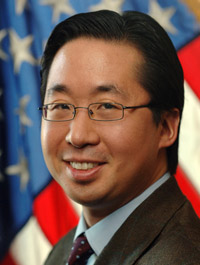Interview with Todd Park Chief Technology Officer of the United States
Prior to becoming Chief Technology Officer of the U.S. in March 2012, and prior to that, CTO at the U.S. Department of Health and Human Services in 2009, Park co-founded three companies that developed web-based and telehealth solutions for doctors and consumers.
Q – Since you joined HHS, what have you learned about making innovation happen in the government?
 I’ve learned that a lot of the same rules that drive success in private sector innovation also apply in the public sector. The philosophy I used extensively in the private sector boiled down to what Eric Ries calls “lean startup” — the whole idea behind lean startup being that you want to engage customers early and rapidly prototype solutions in collaboration with them in order to achieve maximum success.
I’ve learned that a lot of the same rules that drive success in private sector innovation also apply in the public sector. The philosophy I used extensively in the private sector boiled down to what Eric Ries calls “lean startup” — the whole idea behind lean startup being that you want to engage customers early and rapidly prototype solutions in collaboration with them in order to achieve maximum success.
We have successfully applied lean startup principles at HHS across a range of key initiatives. We’ve emphasized the need to rapidly prototype solutions, engage customers in f those solutions as soon as possible, and then quickly and repeatedly iterate those solutions based on working with customers, until we arrive at both an optimal understanding of what customers really want and a solution that delivers what they want..
It’s a technique that a lot of private sector entrepreneurs have used to great effect, and that we’re now using to great effect in the public sector.
Q – How do you then ensure that a good idea or an innovative idea can be scaled up in a government setting, where the culture may be less receptive to something new?
Critical to the success of our growing array of lean startup projects is the following approach: whenever we consider an idea to make the government work differently and better, the first thing we do is find three to five people at HHS who had that idea a long time ago. They know a lot more about it than we do, and can make the change happen if they’re given the chance.
We band those folks together into a “virtual lean startup team,” and we give them the air cover they need and block down field for them, so they can actually do the thing they’ve always wanted to do.
In the case of FDA, through the Entrepreneurs in Residence Program, we’ve also brought in incredibly talented entrepreneurs and experts from the outside, to complement our best internal innovators. Together, they can make amazing things happen in an incredibly short time.
Q – What’s so great about the Entrepreneurs in Residence Program at FDA?
What’s phenomenal about the FDA’s Entrepreneurs in Residence Program is that it’s a living, breathing incarnation of lean startup within HHS. FDA has taken its best internal innovators and put them to work together with entrepreneurs with highly complementary experiences and expertise. The result has been an amazing band of doers and thinkers who are rocking and rolling, and making terrific things happen terrifically fast.
Q – Somewhere, somebody has to give you the green light for these innovations. Where does that start?
In every organization, the tone is set at the very top. And since his first day in office, President Obama has been an incredibly enthusiastic champion of open innovation in government.. He supports the whole idea that government needs to partner with the private sector, the academic sector, and the citizen sector, help unleash the creativity of innovators across these sectors, and team up with them to jointly attack our biggest problems and exploit our biggest opportunities. That’s the overall tone that the President has set, and it provides massively fertile ground for innovation.
Q – What excites you most about FDA’s Innovation Pathway?
Two things: First, the Innovation Pathway will help bring safe and effective medical devices to American patients faster. That will make a huge difference in many lives. And on top of it, the initiative will help medical device companies get their products to market faster and at a lower cost. That will help create jobs and grow the economy.
On another level, I’m enormously excited by the way that the Innovation Pathway project has been run, and by the whole Entrepreneur in Residence, lean startup mode of operation it has embodied. The fact that lean startup has been employed to such great success in the Innovation Pathway project, I think, bodes very well for the replication of this approach more broadly across HHS and the government in general.
Q – What’s the main lessons you’ve learned from the success of FDA’s Innovation Pathway?
The Innovation Pathway at FDA is a phenomenal example of lean startup in action in the government. It proves the success of the whole idea of rapid prototyping, engaging customers and stakeholders as soon as possible, co-inventing an optimal solution through hyper-rapid iteration, and doing all of this at warp speed.
Innovation Pathway exemplifies the power of collaboration. Given the challenges and opportunities that we as a nation face, we’re really only going to be able to get optimal results if we team up as a country.
It’s not about government solving problems by itself. It’s about the private sector, the research sector, the citizen sector, government, and the public in general, teaming up in truly innovative collaborations to deliver optimal results for the American people.
